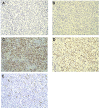Microsatellite Instability in Medullary Carcinoma of the Colon
- PMID: 28458789
- PMCID: PMC5391516
- DOI: 10.4081/rt.2017.6541
Microsatellite Instability in Medullary Carcinoma of the Colon
Abstract
Medullary carcinoma (MC) of the large intestine is a relatively new histological type of adenocarcinoma characterized by poor glandular differentiation and an intraepithelial lymphocytic infiltrate. MC can be associated to a defective mechanism for DNA mismatch repair, caused by the so-called microsatellite instability (MSI). We present the case of a 44 years old Caucasian woman, who referred to the Emergency Room with symptoms mimicking an acute appendicitis. Computed tomography and colonoscopy demonstrated an ulcerated and stenotic lesion of the caecum without signs of metastasis and peritoneal carcinosis. Patient underwent a laparoscopic right colectomy. The final pathologic findings provided the diagnosis of medullary carcinoma with MSI. Patient then underwent adjuvant chemotherapy according to the FOLFOX-4 protocol (association of 5-Fluorouracil, Leucovorin, and Oxaliplatin) for twelve cycles. At two-years follow-up, patient is disease free. MC in association with MSI is a non-frequent tumor of the colon characterized by a better prognosis compared to other types of poorly differentiated adenocarcinoma. In the observed case, 24 months after the surgical operation, the patient is in good health and there is no evidence of metastasis or relapse.
Keywords: colorectal carcinom; medullary carcinoma; microsatellite instability.
Figures


References
-
- Edge SB, Byrd DR, Compton CC, et al. , eds. AJCC Cancer Staging Manual. 7th ed. New York: Springer; 2010.
-
- Lanza G, Gafa R, Matteuzzi M, Santini A. Medullary-type poorly differentiated adenocarcinoma of the large bowel: a distinct clinicopathologic entity characterized by microsatellite instability and improved survival. J Clin Oncol 1999;17:2429-38. - PubMed
Publication types
LinkOut - more resources
Full Text Sources
Other Literature Sources

